What is a nepas (non-grafting) tomato, why is it good, how is it grown and which varieties are considered the best
Low-growing, non-sprouting tomato varieties are in particular demand among beginning gardeners, since they do not require the formation of a bush. The range of such varieties is wide: Carrot, Tayana, Mongolian dwarf, Yamal, Metelitsa and others.
However, breeders continue to work on creating new varieties. So, in 2017-2018. The state register has been replenished with a whole group of non-grafting tomatoes - Nepas (Nepas, Nepas 2, Nepas 3, Nepas 4, Nepas 7, Nepas 9, Nepas 12).
What are non-sprouting tomatoes?
The name of the Nepas variety comes from the adjective “non-stepping”. The variety, or rather a series of varieties, combines non-sapling tomatoes with fruits of different sizes and shades, which practically do not form stepsons.
Their advantages and disadvantages
Tomato bushes of this series are low-growing, from 20 to 70 cm. They are productive and require minimal care. They are distinguished by uniform ripening of fruits. They bear fruit both in greenhouses and in open ground.
Due to the compactness of the bushes and root system, vegetable growers grow more plants in a small area and get a rich harvest. Plants set fruit in any conditions, so they are suitable for open ground not only in the south, but also in the middle zone.
A common drawback of the series varieties is the simple, unsaturated taste of the fruit.
Top best varieties of non-sprouting tomatoes
The Sedek agricultural company has created 14 non-grafting tomato varieties in the series, seven of them are included in the State Register.The varieties of the series are similar, the growing conditions and care do not differ. There is diversity only in the size, color and taste of the fruit. Let’s take a closer look at the seven varieties introduced in 2017 and 2018. to the State Register of Tomato Varieties.
Natalya Petrenko about tomato varieties:
Nepas
A salad variety, early ripening (95-110 days), with a red, flat-round fruit, weighing 50-80 g. The plant is determinate, 50-60 cm high, unpretentious and resistant to temperature changes. Productivity – 6.3 kg/m².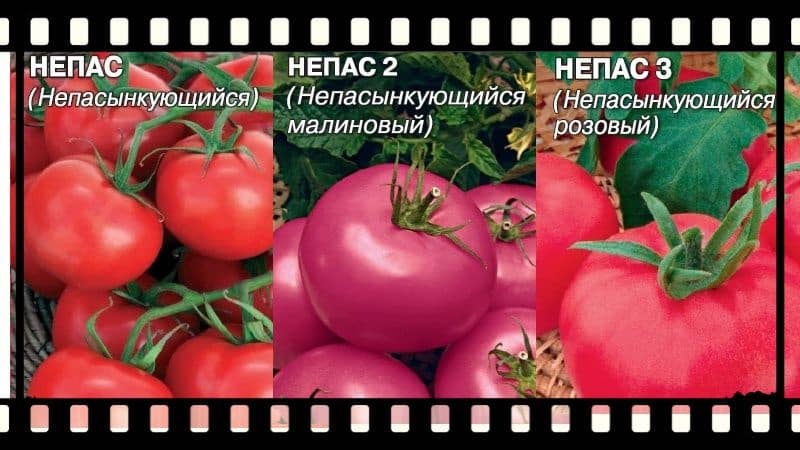
Nepas 2 (non-grazing crimson)
Hybrid F1 for salad use, mid-early, with a raspberry-colored fruit, round in shape, weighing 100-140 g. The plant is determinate, with an average height of 50 cm. The tomato sets fruit well, is resistant to stress caused by unfavorable weather conditions, and is unpretentious. Productivity – 8.2 kg/m².
On a note. Determinate – limited in growth. In such tomatoes, at a certain point, the growth of the central tip stops.
Nepas 3 (pink)
A mid-early variety for salad use, with round, pink fruits (110-140 g). The tomato is determinate, reaches a height of half a meter. The pulp of the fruit is fleshy and sweetish in taste. Productivity – 6.4 kg/m². Suitable for growing without seedlings in areas of unsustainable agriculture. Requires moderate pinching.
Nepas 4 (heart-shaped, orange)
An early variety, for salad use, with beautiful heart-shaped orange fruits with a spout at the end, weighing 60-70 g. The pulp is dense and sweet. Productivity – 6.3 kg/m². The tomato variety is resistant to root and blossom end rot.
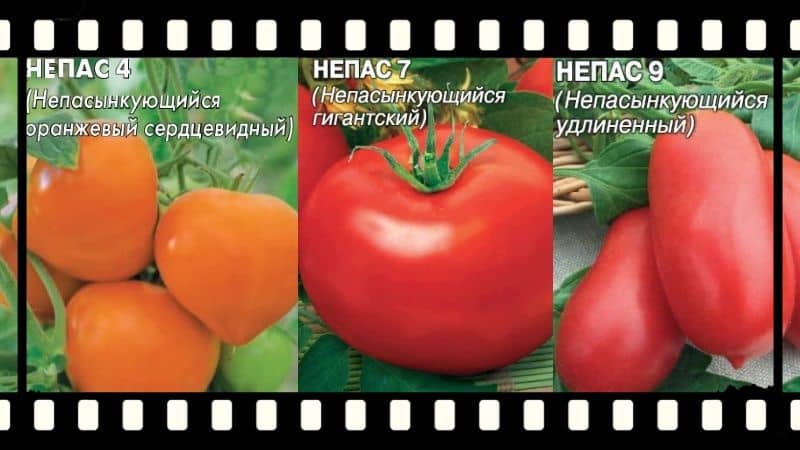
Nepas 7 (giant)
Mid-early, salad, large-fruited (150-200 g). Resistant to tobacco mosaic virus. The fruits are round, red, smooth, and have excellent taste.Productivity – 6.3 kg/m². Indeterminate. The stepson grows moderately.
On a note. Indeterminate – unlimited in growth. The growth of the central tip occurs without restrictions throughout the life of the plant.
Nepas 9
Early, salad, with cylindrical fruits, weighing 50-60 g. The tomatoes are red, dense, fleshy, excellent taste, do not crack. Productivity – 6.3 kg/m². The height of the bush reaches 80 cm. The plant is determinate, 70-80 cm high. Does not require mandatory pinching.
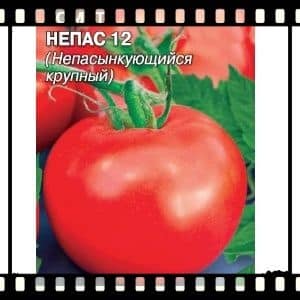
Nepas 12
Ultra-early ripening, salad, with rounded red fruits, weighing 100-150 g. The plant is determinate, up to 50 cm high. The variety is the most unpretentious. Suitable for seedless cultivation in areas of unsustainable agriculture.
Which variety to choose
For preparing salads and fresh consumption, choose: Nepas, raspberry Nepas 2, Nepas 3 with good taste, large-fruited Nepas 7. The fruits of the Nepas 12 tomato are also sweetish with dense pulp.
Excellent pickling varieties: Nepas 4, Nepas 9. Their fruits are dense with a high dry matter content. The heart-shaped Nepas 4 and the elongated Nepas 9 decorate exquisite dishes.
How to grow varieties of the Nepas series
Some “totally lazy” gardeners grow Nepas series tomatoes using the seedless method, that is, they sow their seeds directly into the ground. Since tomatoes are a heat-loving crop, they are sown with seeds in warm beds, box beds or buckets.
We grow non-sprouting tomatoes in buckets
This method has been used since the late 40s of the last century. Back then they used buckets without a bottom. The harvest obtained by this method is no worse, and sometimes even better, than using the conventional method.
What are the advantages of this method? The soil warms up well in a bucket; under unfavorable conditions, it can be brought into a greenhouse or even into a house, no need to weed. The sun illuminates the plants well. They can be used for garden decoration.
In metal containers and black containers, the soil warms up especially well, which accelerates the growth of tomatoes. Water and fertilizers are not wasted, the plant receives them completely.
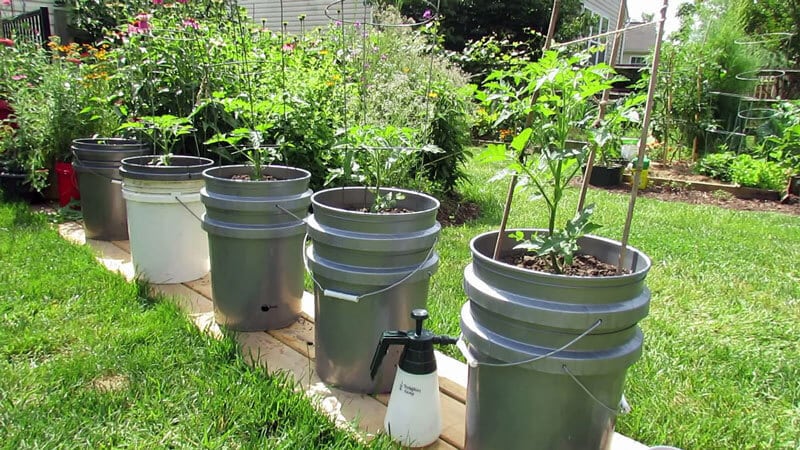
The soil for growing tomatoes in buckets is prepared from turf soil (medium loam), humus in equal parts, 300 g of wood ash is added to 1 bucket, peat or sawdust is added. The soil is steamed over an open fire and watered with a solution of rich pink potassium permanganate, diluted at the rate of 1 g per 10 liters of water.
If there are any, holes are made in the bottoms of the buckets so that the water does not stagnate. However, it should be taken into account that if the holes are too large, the water will quickly “leave”, so some gardeners do not make holes, but simply put drainage (broken brick, expanded clay, etc.) on the bottom, covering the top with non-woven material.
What are the advantages of planting tomatoes in buckets, what are the nuances of caring for them in this method - watch the video about this.
How to grow tomatoes in buckets (Alenin's garden):
In box beds
Growing low-growing tomatoes in box beds is popular. What is a box bed? This is a high bed, fenced with wooden frames made of boards or rods. Experts consider the most convenient size for such beds to be 6 m long and 1.2 m wide, but this depends on your capabilities.
Arches are installed over the ridges, on which covering material (film, non-woven material) is laid to extend the season, speed up the ripening of the crop, and protect the plants from the vicissitudes of the weather.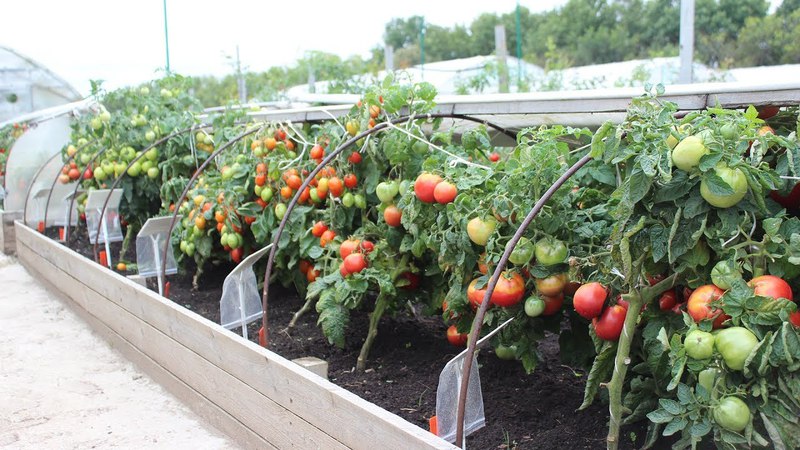
A box bed is formed from plant residues and food waste, which provide heat during rotting, so tomatoes can be grown in them directly from seeds.
Tips and tricks
Buy seeds in trusted, specialized stores. Pay attention to the packaging. It must indicate the variety, manufacturer, number of seeds, and date of manufacture.
To get a good harvest, caring for plants is necessary, despite their unpretentiousness. Nepas series varieties are left unattended for 1-2 weeks in favorable weather, but it is important to ensure watering once every ten days.
Bushes are necessary tie up, weed, loosen the soil, every two weeks feed.
The basic agrotechnical methods are the same as for other varieties, with the exception of pinching and bush formation.
Reviews
This is how Valentina Vladimirovna Redko, a well-known tomato collector in Russia, speaks about the Nepas series tomatoes: “It’s difficult to grow - it’s no longer interesting. So that it would be fruitful, abundant, easy, and the Nepas 12 non-grafting large tomato was bred. With this variety, you can either go to peace or go to a feast.”
Lorena Mil35 (Ekaterinburg) writes: “Nepas tomatoes bear fruit abundantly, but they require staking. I liked the variety of tomato seeds Nepas because it does not require pinching. It is grown in the usual way, the seeds are planted for seedlings in March, at the end of May the seedlings are planted in greenhouses or hothouses. The Nepas variety is early ripening, the tomatoes turn red already in July, one of the first. The variety bears fruit abundantly, the bushes are not tall, but spreading, and requires tying for support, as it cannot bear a lot of fruit.”
Seleznev Boris Sergeevich (Kingisepp): “I live in the Leningrad region, where temperature changes are often observed.Because of this, difficulties arise in growing tomato seedlings by the required date. Often the plant developed before the cold weather subsided and the soil warmed up to the desired temperature. I consider the Nepas No. 12 tomato my salvation, since it can be grown without seedlings at the moment when optimal weather conditions have established outside.”
Magrat writes: “I welcome non-pinching varieties, since I always miss the time of “pinching.” Productivity 3.7-4.5 kg/sq.m. I didn’t check the scales, but for my not-so-favorable growing conditions, the yield is more than decent. The value of the variety: resistance to stress caused by unfavorable weather conditions - I don’t quite agree. He was the first to react to the drop in temperature. I didn’t even understand when he managed to freeze! The rest stood up cheerfully and continued to sing! I really liked the variety. The manufacturer's promises have been fulfilled. I’ll add the following on my own behalf: despite his short stature, he needs support. Even better is a straight triangle for each bush, because it is REALLY productive. So much so that the trunk can’t stand it.”
Svetlana M. (Asha): «Vegetable gardening is one of my favorite pastimes, however, in our climatic conditions it is difficult to get a large harvest, and there is a little more work to do with the plants. I prefer non-sprouting and early ripening varieties, such as non-sprouting raspberry or plum. They form neat bushes, ripen quickly and allow you to enjoy the results of your own labor even in the summer months. I roll up the plum-shaped one for the winter, and the whole family eats the pink one with pleasure.”
Alexey V. (Novoorsk): «Our summers are warm, even hot, but dry and short.Growing crops is sometimes difficult, so before I buy a new variety, I read its description and reviews from gardeners. This helps me understand which seeds are worth buying in the store and which are not. I bought the last curiosity - the non-grazing striped tomato, I really liked the appearance of the tomato, and the description of the variety was good. The yield is sufficient, although I don’t plant much, rather just for fun, but it’s enough for salting.”
Read also:
What is mulching and why is it needed?
Conclusion
Nepas tomatoes are good because they are easy to care for and resistant to diseases and extreme weather conditions. And most importantly, they do not need to be sown, which means farmers save their time and effort. In the central and southern regions, the Nepas variety is often grown without seedlings in open ground. Even a novice gardener can cope with growing such tomatoes.
Tomatoes for the lazy: